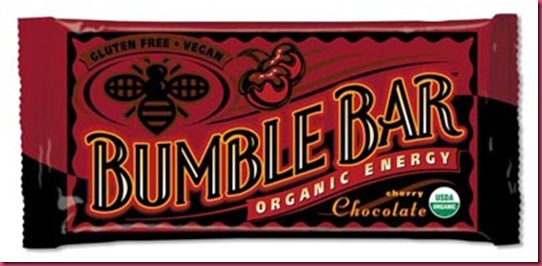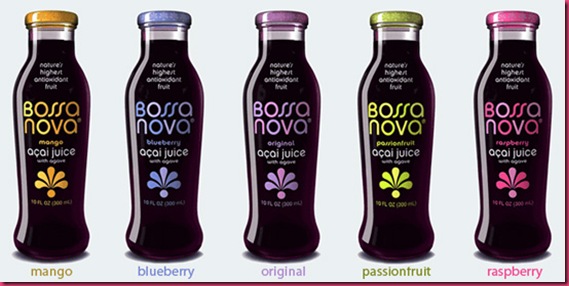Bar Review 4/5 and a bonus!
|
Today’s Bar: Bumble Bar Organic Energy in Cherry Chocolate |
| Package Goodies: Gluten Free & Vegan. There is also a random picture of a pretty cute little kid’s head floating on the back of the package and it says “Abby Adores Em!†and “Abby les adore!†for those French speakers out there. “BumbleBar is a delicious blend of organic, simple, whole foods. Made only from certified organic, gluten free, dairy free, ethically sourced ingredients, BumbleBars are the purest form of energy!â€
Pretty neat! Ingredient List: Organic agave syrup, Organic sesame seeds, Organic cherries, Organic non-dairy chocolate, Organic flax, Organic almonds, Organic coconut, Organic cocoa powder, Organic cherry flavor, Organic chocolate extract, Sea Salt, Tocopherol. Our bookstore only had regular chocolate and cherry chocolate flavors, but looking at the website, they have a ton of different choices!
The Verdict: Wow! This is like the healthy kid’s no bake cookie. This is not a cookie bar or anything like that…it’s basically the seeds, nuts and fruits that are listed in the ingredients, smooshed together with some dark chocolate and rolled flat. I loved it! At first, it was a bit strange, since it was pretty different from the bars I’ve had the rest of this week so far. But after I tried a little more, I was completely hooked. Each bite tastes a little different because you’re getting a different bite of fruits and seeds and things. Some bites are sweeter, while others have a sour punch from dried cherries. Some are more chocolatey than others. Overall, it has a very clean chocolate taste, with nice pops of the different things that make up the bar. I would totally recommend this to people who love chocolate, seeds/nuts, OR chewy things! I want to try more flavors now for sure! I hope I can find these at Whole Foods where they have more of a selection! |
|
Bonus Review! |
| Today with my lunch, I was feeling the need for juice over my regular water. I went for something new: Bossa Nova Superfruit Açai Juice! They had a few different flavors to choose from, and I went with Raspberry.
Bottle Claims: “highest antioxidant fruitâ€, “Rethink Juice! Choose superfruits. Meaningful nutrition. Vital performance. Reject empty calories. No apple, grape, pear or cane juice fillers.†“Not all fruits are created equal. Superfruit: Açai (ah-sci-ee). Taste: Lush, tropical dark berry with a blueberry note. Superpower: Highest antioxidant fruit. Benefit: Reduces free radicals linked to premature aging, heart disease, Alzheimer’s and certain cancers; anti-inflammatory benefits; supports recovery after exercise. Profile: About 60% more antioxidants than pomegranates with about 40% less sugar; sustainable harvesting helps preserve rainforest ecosystems.†“Naturally Occuring Nutrients: Antoyanins (powerful antioxidants), Vitamin A, Magnesium†What a mouthful! For a tiny bottle, this was PACKED with random claims and exclamation points! Ingredient List: Wild-harvested Açai Juice, Organic Agave Nectar, Raspberry Juice (from concentrate), Natural Flavors* Nice and short…sort of. See below for some interesting ideas about “Natural Flavors.â€
The Verdict: Yum! This was a very powerful juice. Lots of flavor, so it’s a good thing it came in a little bottle, because otherwise I probably wouldn’t have finished it. It went really nicely with my lunch (leftover Italian wedding casserole) and was a great sweet break from my many cups of water throughout the day. I may try some of the other flavors, but these little guys cost around $3! Definitely a special occasion…free water from the office is my drink of choice on a daily basis! |
* A note about natural flavors: I haven’t done a tone of research, so don’t use me as some expert witness to this, but in one of my grad classes a couple years ago, we read Eric Schlosser’s Fast Food Nation. Really really interesting. He has a lot to say about flavors (natural and artificial), and the way that flavors are manufactured in giant factories. Schlosser does a pretty decent job of citing the claims that he makes, so while I’m not going to throw him out there as an irrefutable scientific resource, his concerns in this area are ones that I tend to have as well. Here’s a brief excerpt (which I snatched from a random website in order to avoid having to type it all)…there is a lot more interesting stuff in the book. I’d definitely recommend it.
The Food and Drug Administration does not require companies to disclose the ingredients of their color or flavor additives so long as all the chemicals in them are considered by the agency to be GRAS (“generally recognized as safe”). This enables companies to maintain the secrecy of their formulas. It also hides the fact that flavor compounds often contain more ingredients than the foods to which they give taste. The phrase “artificial strawberry flavor” gives little hint of the chemical wizardry and manufacturing skill that can make a highly processed food taste like strawberries.
A typical artificial strawberry flavor, like the kind found in a Burger King strawberry milk shake, contains the following ingredients: amyl acetate, amyl butyrate, amyl valerate, anethol, anisyl formate, benzyl acetate, benzyl isobutyrate, butyric acid, cinnamyl isobutyrate, cinnamyl valerate, cognac essential oil, diacetyl, dipropyl ketone, ethyl acetate, ethyl amyl ketone, ethyl butyrate, ethyl cinnamate, ethyl heptanoate, ethyl heptylate, ethyl lactate, ethyl methylphenylglycidate, ethyl nitrate, ethyl propionate, ethyl valerate, heliotropin, hydroxyphenyl-2-butanone (10 percent solution in alcohol), a-ionone, isobutyl anthranilate, isobutyl butyrate, lemon essential oil, maltol, 4-methylacetophenone, methyl anthranilate, methyl benzoate, methyl cinnamate, methyl heptine carbonate, methyl naphthyl ketone, methyl salicylate, mint essential oil, neroli essential oil, nerolin, neryl isobutyrate, orris butter, phenethyl alcohol, rose, rum ether, g-undecalactone, vanillin, and solvent.
Although flavors usually arise from a mixture of many different volatile chemicals, often a single compound supplies the dominant aroma. Smelled alone, that chemical provides an unmistakable sense of the food. Ethyl-2-methyl butyrate, for example, smells just like an apple. Many of today’s highly processed foods offer a blank palette: whatever chemicals are added to them will give them specific tastes. Adding methyl-2-pyridyl ketone makes something taste like popcorn. Adding ethyl-3-hydroxy butanoate makes it taste like marshmallow. The possibilities are now almost limitless. Without affecting appearance or nutritional value, processed foods could be made with aroma chemicals such as hexanal (the smell of freshly cut grass) or 3-methyl butanoic acid (the smell of body odor).
The 1960s were the heyday of artificial flavors in the United States. The synthetic versions of flavor compounds were not subtle, but they did not have to be, given the nature of most processed food. For the past twenty years food processors have tried hard to use only “natural flavors” in their products. According to the FDA, these must be derived entirely from natural sources — from herbs, spices, fruits, vegetables, beef, chicken, yeast, bark, roots, and so forth. Consumers prefer to see natural flavors on a label, out of a belief that they are more healthful. Distinctions between artificial and natural flavors can be arbitrary and somewhat absurd, based more on how the flavor has been made than on what it actually contains.
“A natural flavor,” says Terry Acree, a professor of food science at Cornell University, “is a flavor that’s been derived with an out-of-date technology.” Natural flavours and artificial flavors sometimes contain exactly the same chemicals, produced through different methods. Amyl acetate, for example, provides the dominant note of banana flavor. When it is distilled from bananas with a solvent, amyl acetate is a natural flavor. When it is produced by mixing vinegar with amyl alcohol and adding sulfuric acid as a catalyst, amyl acetate is an artificial flavor. Either way it smells and tastes the same. “Natural flavor” is now listed among the ingredients of everything from Health Valley Blueberry Granola Bars to Taco Bell Hot Taco Sauce.
A natural flavor is not necessarily more healthful or purer than an artificial one. When almond flavor — benzaldehyde — is derived from natural sources, such as peach and apricot pits, it contains traces of hydrogen cyanide, a deadly poison. Benzaldehyde derived by mixing oil of clove and amyl acetate does not contain any cyanide. Nevertheless, it is legally considered an artificial flavor and sells at a much lower price. Natural and artificial flavors are now manufactured at the same chemical plants, places that few people would associate with Mother Nature.
Iiiinteresting, no? I am definitely not one to condone anything for being not completely healthy, but I like bits of info like this that make me think about food labels and ingredient lists differently. Makes me feel like I am not so swayed by all of the marketing gimmicks that are out there.
This entry was posted on Thursday, April 9th, 2009 at 10:08 pm and is filed under Fun, reading, Yum. You can follow any responses to this entry through the RSS 2.0 feed. You can leave a response, or trackback from your own site.




4:32 pm on April 10th, 2009
[…] for me. I’d have to say the winner for the week (who knew this was a contest!?) is the Bumble Bar from Thursday! Mostly because it was so unexpected and it really grew on me as I ate it. I can’t wait to try […]
7:50 am on April 11th, 2009
That is so interesting. I know you mentioned the artificial flvaor vs natural one to me before. Its hard to believe though.
11:19 pm on March 8th, 2012
Some of us have been part of this community http://www.dumblittleman.com/ for decades, assisting people whom require a swiftly cash payday loan, and additionally doing certain company as a pawn broker on the side.